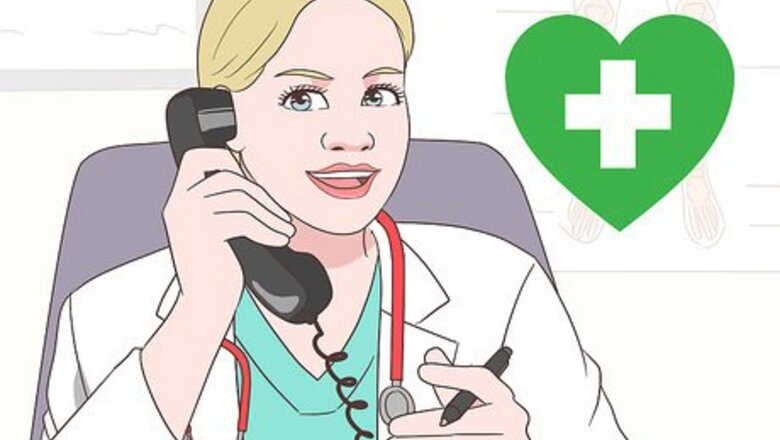
views
Treating the Acne Medically
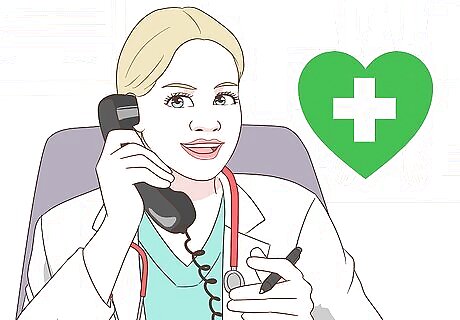
Make an appointment with your dermatologist. The fastest and most effective way to fight cystic acne is through medical treatment from a dermatologist. Your dermatologist can prescribe the medications or perform non-invasive procedures. If you don't have a dermatologist, ask your primary care physician for a referral. You can also look up a dermatologist online. Tell your dermatologist if you are pregnant or breastfeeding.
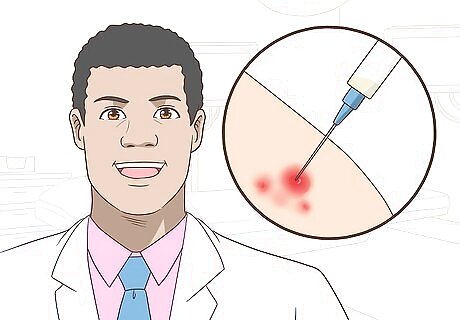
Ask the dermatologist to drain and extract the cyst. In this procedure, your dermatologist will drain the cyst with a sharp needle. This is the fastest way to remove a cyst. When done properly, it can reduce pain, swelling, and scarring as well. Never try this at home or without the supervision of a licensed professional. Improper lancing may result in scarring or infection. In some cases, your dermatologist may also inject the cyst with medication.
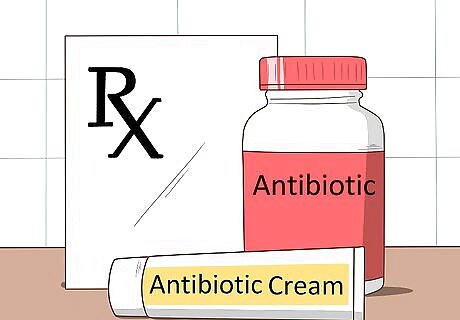
Get a prescription for an antibiotic. Antibiotics work by killing the bacteria that causes acne. Your dermatologist may prescribe you a pill to swallow daily or a cream to apply directly to the acne itself. These require a prescription. Side-effects of antibiotics include increased sensitivity to the sun, liver damage, and complications with pregnancy. Follow your dermatologist's instructions regarding the use and dosage of antibiotics.
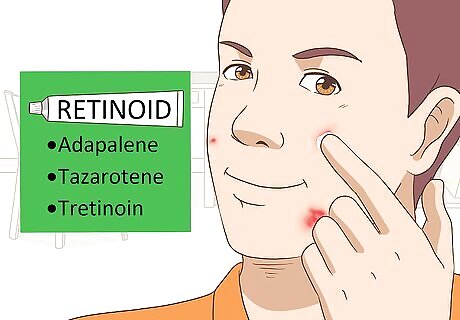
Get a topical retinoid to apply to your skin. Topical retinoids unplug clogged pores, allowing other medications to come in and fight the acne-causing bacteria. Apply the retinoid to your face once a day. Most retinoids require a prescription. Weak doses are available over the counter, but these may not have as dramatic an effect. Retinoids are usually reserved for moderate to severe acne, when other methods of treatment have not worked. Types if topical retinoids include Adapalene, Tazarotene, and Tretinoin. Topical retinoids may initially make your acne worse before it gets better. It can take a few weeks to see results. Talk to your doctor about possible side-effects. Side effects include increased sensitivity to the sun, dryness, redness, and peeling of skin.
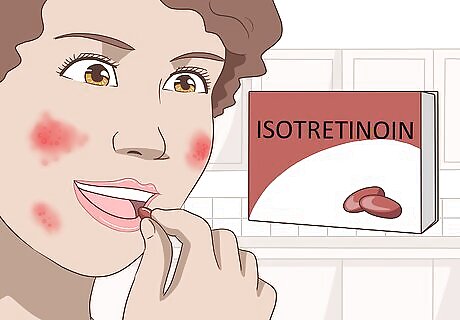
Take a systemic (oral) retinoid for severe cystic acne. If other treatments haven't worked, a retinoid pill, such as isotretinoin (also called Accutane), may be your best option. Take the retinoid by mouth according to your dermatologist's instructions. Isotretinoin may cause some very serious side effects. These include depression, birth defects, miscarriage, deafness, and bowel disease, among others. Only the worst cases of cystic acne may warrant prescription of this very strong drug.
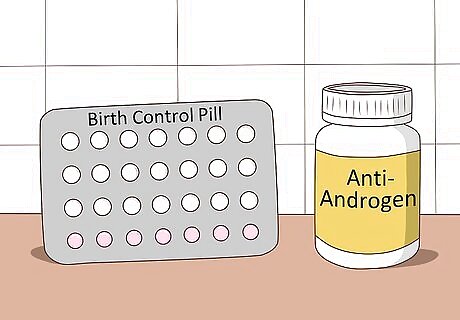
Undergo hormonal treatments for women. Acne is affected by our body's hormones. A birth control pill or anti-androgen medications may help stem outbreaks. Talk to your doctor about medications that may limit the severity of your cystic acne. Understand the possible side-effects. Side-effects include irregular menstrual cycle, fatigue, dizziness, and breast tenderness. Women with a high risk or previous history of high blood pressure, stroke, heart disease, blood clots, or breast cancer should not go on hormonal medication.
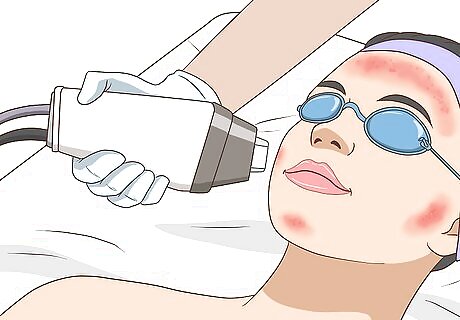
Zap off cysts with laser therapy. Traditionally used to remove scars, laser therapy may now be used to treat acne itself. Laser therapy burns away the follicle sac, by burning away the sebaceous gland (which produces oil), or by oxygenating the bacteria, and thereby killing them. Moderate to severe cases of cystic acne may require multiple sessions in a 4 week spa, but you may see results after the first treatment.
Developing a Daily Skincare Routine
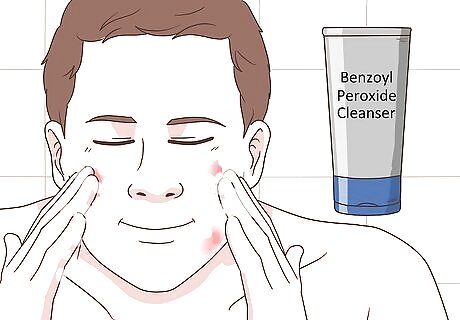
Wash your face twice a day with benzoyl peroxide cleanser. Benzoyl peroxide helps fight acne by reducing oil and bacteria. Wash your face in the morning and evening by dampening your face and applying the cleanser. Rinse off thoroughly and pat your face dry with a clean towel. If you wear makeup, be sure to remove it completely before washing your face. Use makeup removing wipes or solution to help remove all of your makeup. You can buy cleansers containing benzoyl peroxide at grocery stores, beauty stores, and pharmacies.

Apply a toner with salicylic acid after you wash your face. Your toner will help remove any last particles of dirt while fighting the acne. Dampen a cotton pad with the toner and gently wipe across your face to apply the toner. Salicylic acid can help unplug pores and may prevent clogged hair follicles. If you're pregnant, you might try products that contain azelaic acid instead. These may be safer for pregnant people, though salicylic acid is unlikely to be a risk.
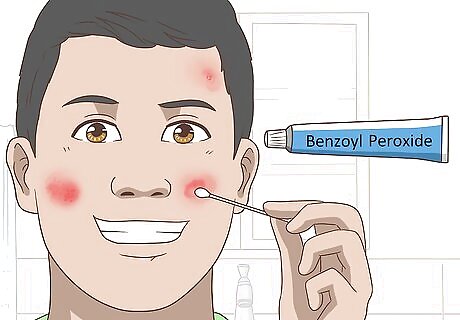
Apply a spot treatment with benzoyl peroxide. Once your face is clean, dab some benzoyl peroxide cream or gel onto your acne. This can help reduce the acne more quickly. You can get spot treatments from your dermatologist or over the counter at pharmacies and grocery stores.

Moisturize after each wash with a non-comedogenic moisturizer. Your skin needs moisture after you strip it of oil and water. Use non-comedogenic moisturizers that won't block your pores. These should be marked as “non-comedogenic” on the label. Common ingredients in non-comedogenic moisturizers include hyaluronic acid, glycerin, and aloe vera.
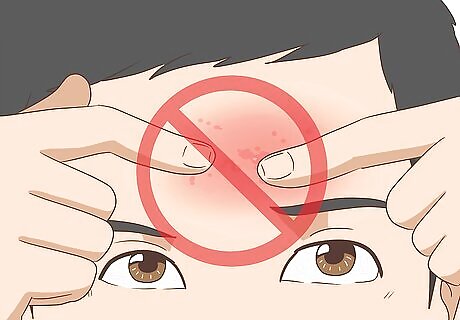
Avoid touching or picking your acne. As hard as it is, try not to touch your face or feel your pimples. Cystic acne can get inflamed when touched, producing more redness and irritation. It may also increase scarring. Try sitting on your hands if you feel the urge to touch your face. Distract yourself by chewing gum, taking a walk, or squeezing a stress ball. Cystic acne is much harder to pop than normal acne, and doing so will possibly make it worse. Trying to pop cystic acne will also be more painful and more likely to leave a scar.
Adjusting Your Lifestyle
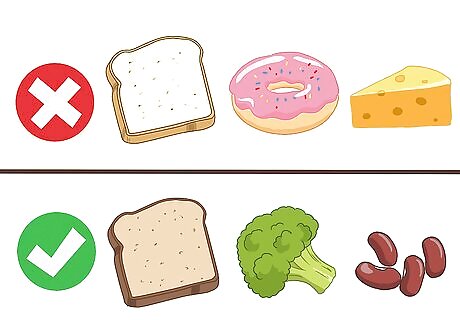
Eat a low-glycemic diet. What you eat may contribute to acne. A low-glycemic diet can help reduce the severity of your acne. Eat plenty of whole grains, beans, and veggies. Cut back on processed carbs, white bread, pasta, dairy, and refined sugar. Instead of drinking soda or juice, drink water or herbal tea when you're thirsty. Watch out for dairy in particular. Dairy may worsen acne in some people.

Quit smoking. Smoking can worsen or cause acne in adults. Talk to your doctor about quitting smoking. They can prescribe you pills or patches to help make the process easier.
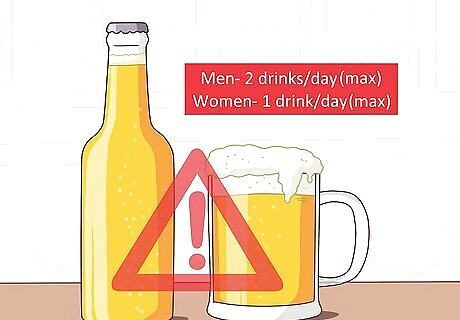
Cut down on alcohol. If you're a regular drinker with cystic acne, reduce how much you drink. In general, men should have no more than 2 alcoholic drinks a day. Women should limit themselves to 1 drink.
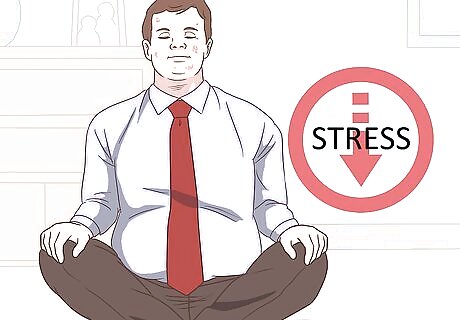
Reduce your stress. Stress can worsen acne, especially for men. While stress is notoriously difficult to control, you can try to incorporate some relaxation techniques to keep your stress more manageable. Exercise can relieve stress. If nothing else, take a walk or stretch. Meditation can help bring a sense of peace back in your life. If you're busy, squeeze in 5 minute meditation sessions at work, school, or during a lunch break. If you feel yourself becoming overwhelmed, pause and breathe deeply for 10 seconds. Make sure to get between 7-9 hours of sleep a night. Sleep deprivation can cause you to feel more stress, which can cause more acne.
Reducing Acne Scars
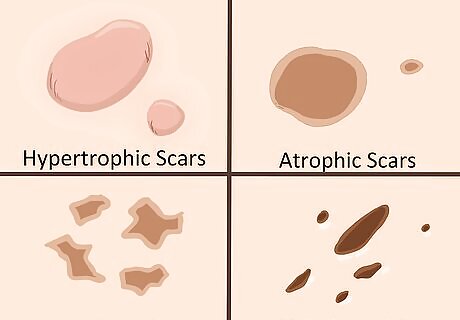
Identify any scarring left over from the acne. Scarring is more common in cystic acne because of the collagen-damaging infection of deep tissue. The best treatment for scars depends on the type of scar. These types include: Hypertrophic scars are raised up from the skin. These can be treated with creams. Atrophic scars are sunken but mostly shallow. These can be treated with peels, dermabrasion, or laser treatments. Boxcar-shaped scars are shallow and broad with jagged edges. These can be treated with lasers, dermabrasion, or excision (surgery). Ice pick-shaped scars are narrow and deep. Lasers, dermabrasion, and excision are effective treatments.
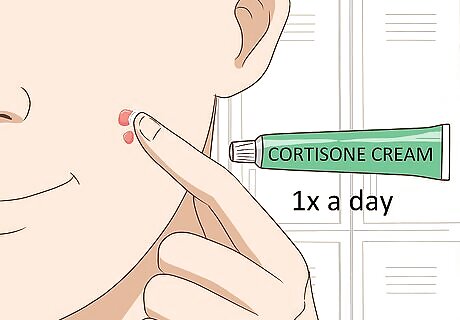
Apply cortisone cream to reduce inflammation in hypertrophic scars. Once a day, pat the cream onto any scar that is red and swollen. The cream may reduce the appearance of the scar. It works best on red, swollen, and raised scars.
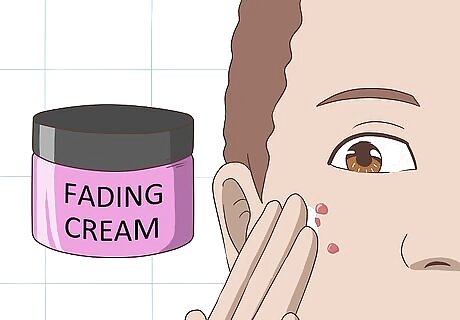
Rub fading creams onto the scar to help reduce their appearance. There are many creams that can help reduce the appearance of scars after acne. These usually contain ingredients like hydroquinone, kojic acid, arbutin, or licorice extract. These creams can be bought at pharmacies, beauty stores, and grocery stores. Apply these creams once or twice a day to your acne scars. This is most effective with raised or red scars.
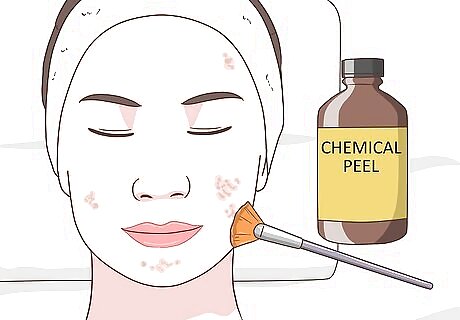
Get a chemical peel at a dermatologist's office or spa. Chemical peels use potent acid formulas to lift off the top layer or layers of skin, minimizing the appearance of scars. These offer dramatic effects in a short time. The doctor will apply an acidic solution to your face. Types of peels include glycolic acid, salicylic acid, and Trichloroacetic acid (TCA). Always wear sunscreen after getting a peel, as your skin will be more sensitive to the sun. You may feel burning or irritation during the peel. If it is too much to handle, tell your dermatologist. Stronger peels may cause peeling, redness, or swelling after the procedure. Your dermatologist will give you lotion to help reduce the discomfort. Weaker peels can be done at home, but be careful. Ask your dermatologist for advice before trying a home peel.
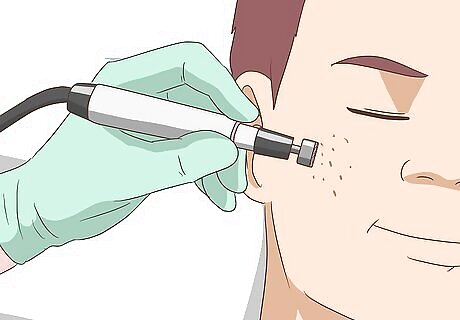
Go to a spa or dermatologist for dermabrasion. Dermabrasion sloughs off top layers of skin with a wire brush. Blemishes on the surface of the skin are usually removed, and deeper scars are minimized. Dermabrasion can cause changes in skin pigmentation for patients with dark skin For a less intense procedure, try microdermabrasion. Your dermatologist will apply small crystals onto the top layer of skin and vacuum them up, along with dead skin cells. Results are generally less pronounced than dermabrasion.

Undergo laser treatments to remove deep scars. Lasers blast the outer layer of skin (epidermis) and heat the layer of skin just beneath it. As the skin heals, so do the scars. Sometimes, multiple laser treatments are needed to lessen the visibility of scars.
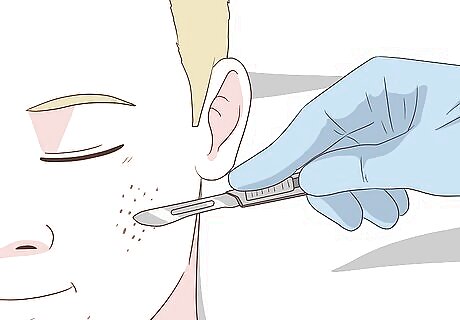
Get surgery to fix large scars and lesions. These surgeries are usually non-invasive. Your doctor might cut out the scar with a punch excision and replace it with stitching or a skin graft. Alternatively, they may use a needle to relax the muscle fibers under the skin.
















Comments
0 comment